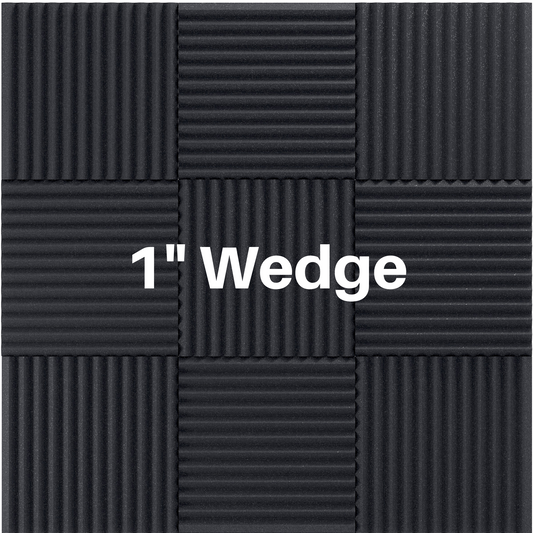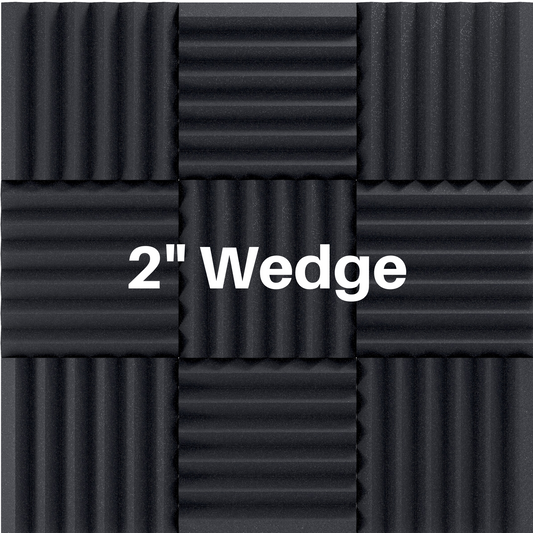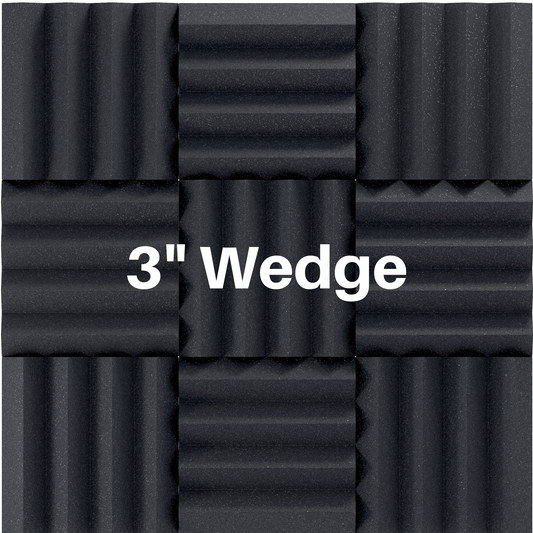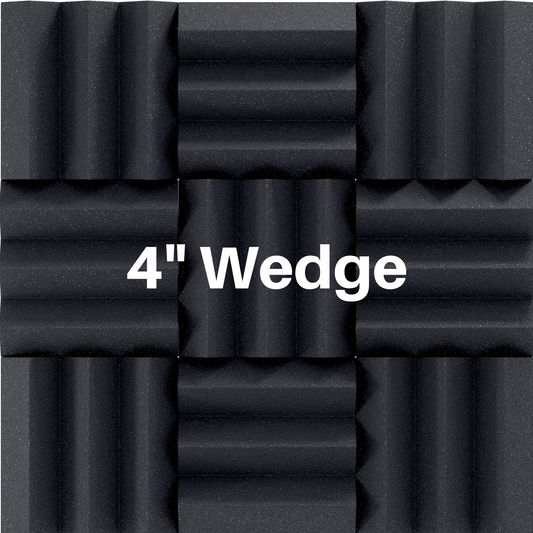Is Acoustic Foam Worth It?
Share
Are you wondering if acoustic foam is worth the money for you to invest? Let's take a look at what acoustic foam does and see if it is the right acoustic treatment for your sound problem!
What Does Acoustic Foam Do?
Acoustic foam is a soft porous material that absorbs sound waves by turning the sound waves to heat by friction. This basically means that acoustic foam panels will absorb sound waves rather than the sound bouncing off flat surfaces like painted drywall.
The below illustrations demonstrate how acoustic foam will absorb sound waves and prevent them from bouncing off flat surfaces.


Our acoustic foam is available in four thicknesses. The thickness of the foam determines what frequency of sound the panel can absorb.
Thinner acoustical foams will absorb high end sound waves while thicker acoustic foam will absorb high, mid range and low end frequencies. Bass traps are extra thick and absorb the lowest of the low frequencies.
The fact that thicker material absorbs lower frequency waves is based on science. The low end waves are physically longer and thus need a thicker material to absorb the wave fully.
Below you will see our NRC ratings for the different thickness of acoustic foam.

What Problems Does Acoustic Foam Solve?
Now that you know acoustic foam can absorb sound waves let's see why this is useful!
Acoustic foam can solve various acoustic problems you may be having.
- Too much echo
- Too much reverberation
- Standing waves
These are common problems in a recording studio, broadcast booth, gaming room, podcast room or any environment where you may be recording audio.
- Do your recordings sound echoey and jumbled?
- Is it hard to mix using your monitors because of too much reverb in your room?
- Is there an echo in your podcast?
- Is it hard to communicate while gaming because too much echo?
Acoustic foam can help you with these problems!
Many restaurants, offices, places of worship and schools also face problems with too much echo and reverberation.
- Do your customers complain that your restaurant is too loud and they can't have a conversation?
- Is there too much echo and commotion in your office because of open spaces and flat surfaces everywhere?
- Are you having problems with too much reverb and the congregation cannot hear the pastor speak?
- Is there too much echo in your classroom making it difficult to teach effectively?
Acoustic foam can also help with these problems!
What Acoustic Foam Will NOT Do
Acoustic foam in not designed to block sound or to completely soundproof a room. Many people think that acoustic foam will soundproof a wall and make it so sound will not travel through. This is not true!
Don't feel bad if you were thinking acoustic foam would do this, you are not alone!
This misconception comes from the fact that many musicians and people in general use the term "soundproofing foam" or "soundproofing panels" to refer to the acoustic foam wedges that are seen in many recording studios. Students in the Berklee Acoustics course chat even referred to the panels as "soundproofing".
Acoustic foam will not stop outside noise from coming in! Many people who live in big cities or by a train track reach out and want to cover a wall or window with acoustic foam to stop outside noise from coming in and keeping them up at night. Acoustic foam is not designed to do this!
Applying foam on the wall or window may help muffle the sound a tad, but it will not stop the noise completely.
A better solution for soundproofing is our Neoprene Sound Blocking Sheets!
What Is The Best Acoustic Foam For My Needs?
When considering your acoustic foam needs you need to take into consideration the thickness of the foam and the amount of coverage in your room.
--
Our foam comes in four thicknesses: 1, 2, 3 and 4 inches thick.
1 inch thick acoustic foam will give you the most bang for your buck. 1" foam panels are thin compared to our other foams, but are still effective for reducing flutter echoes and controlling the mid and high frequency ranges. Use these panels when good sound control is desired but complete absorption is not imperative.
2 inch thick acoustic foam offers more sound absorbing power overall, and will take care of the mid to high frequency ranges. The 2" thick profile is the most popular and a safe bet for anyone planning a DIY vocal booth, recording studio, home theater, rehearsal space, broadcasting area, and more!
3 inch thick acoustic foam will help absorb high, mid, and low end frequencies. These versatile panels can be used in almost any room.
4 inch thick acoustic foam has the highest sound absorbing power, and will help eliminate lower end frequency ranges. Use these panels in rooms where a high degree of sound absorption is desired.
Bass Traps are the thickest and a must for any room with a subwoofer, drum kit or bass amp.
--
The amount of coverage in your room depends on the use for your space. Use our acoustic foam room calculator to calculate your needs.
Acoustic Treatment Recommendations:
Light Treatment
Wall Coverage: 8% to 10%
Example Spaces: Play Rooms, Gyms / Workout Rooms, Classrooms, Conference Room
Medium Treatment
Wall Coverage: 15% to 20%
Example Spaces: Offices, Churches, School Gymnasiums, Coworking Spaces
Heavy Treatment
Wall Coverage: 25% to 35%
Example Spaces: Recording Studios, Jam Rooms, Home Theaters, Broadcast/Podcast Spaces
If you are planning a home recording studio, podcast booth, rehearsal space, or any other acoustic project and you have questions please fill out our free acoustic foam room analysis. We will provide you with some free advice on the best acoustical treatment for your needs.
DIY Alternatives To Acoustic Foam
There are many DIY alternatives to acoustic foam including making your own acoustic panels, using other soft items for decor, putting up thick curtains, or even moving blankets in some cases. I've seen people use 4-5 moving blankets to create a makeshift vocal booth, and it sounded pretty good!
Just remember that soft and fluffy materials will absorb sound; flat surfaces will reflect sound! If you have too much echo and reverb then you need to figure out the best way for you to add something to the room that will absorb sound rather than reflect it.
Check out our friend That Home Theater Dude making his own acoustic panels! We also offer a special acoustic foam Home Theater bundle by That Home Theater Dude!
Alternatives To Acoustic Foam
There are other options than acoustic foam when it comes to sound absorption. These products will produce similar results as far as sound absorption to acoustic foam but have a different aesthetic appeal. Many alternatives to acoustic foam are also more expensive.
QuadCork Sound Absorbing Tiles

Fabric Covered Acoustic Panels (24x24x2 Inches)

Fabric Covered Acoustic Panels (24x48x2 Inches)

Sound Absorption-Diffuse Acoustic Panel

More Info
If you still have questions we are glad to help you! Please contact us anytime or fill out our free acoustic room analysis!
Read More:
Will Acoustic Foam Soundproof A Room ?
Acoustic Treatment For Home Recording Studios - Multiple Design Ideas
Home Theater Acoustic Treatment - DIY Video Instructions
What Is Transmission Loss Of Sound ?
What Is Noise Reduction Coefficient (NRC) ?
Full line of acoustic foam!
Check out more acoustic foam panels and corner solutions!














